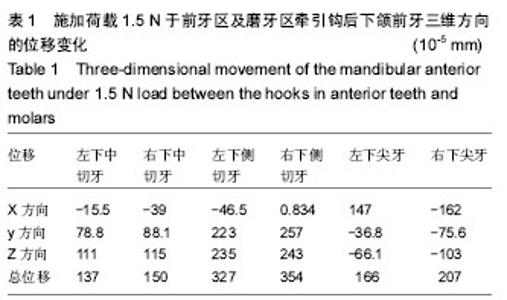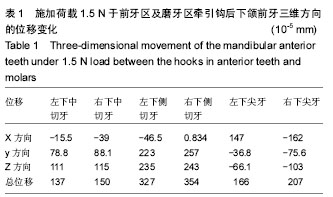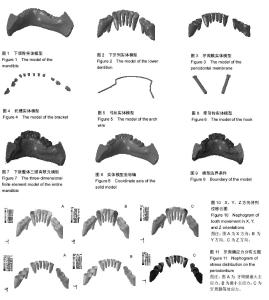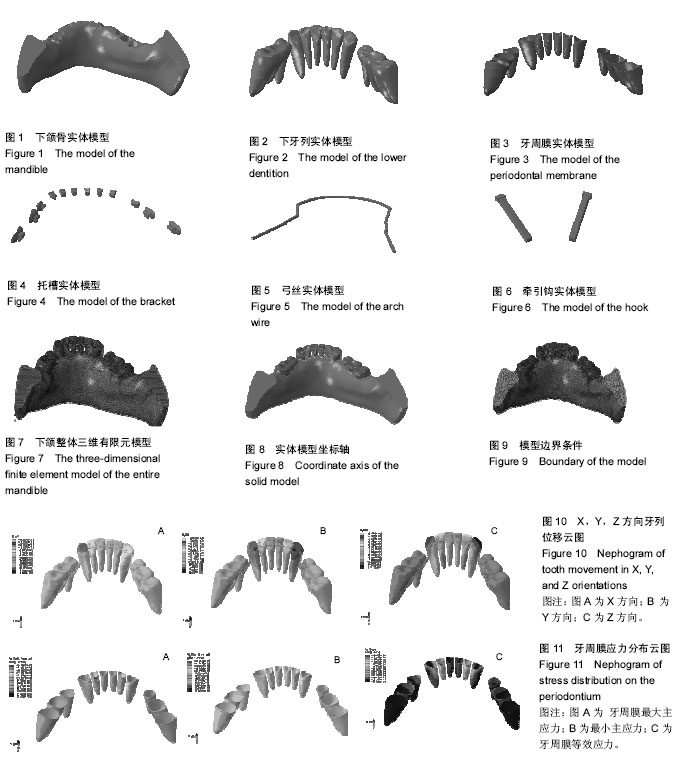| [1] Deguchi T, Terao F, Aonuma T, et al. Outcome assessment of lingual and labial appliances compared with cephalometric analysis, peer assessment rating, and objective grading system in Angle Class II extraction cases. Angle Orthod.2015; 85(3):400-407.[2] Liang W,Rong Q,Lin J,et al.Torque control of the Maxillaary incisors in lingual and labial orthodontics:a 3-dimensional finite element analysis.Am J Orthod Dentofac Orthop. 2009; 135(3):316-322.[3] Mo SS,Kim SH,Sung SJ,et al. Torque control during lingual anterior retraction without posterior appliances. Korean J Orthod.2013;43(1):3-14.[4] 蔡留意.个体化舌侧矫治器微种植体支抗滑动法内收上前牙的生物力学特征研究[D].郑州:郑州大学,2012[5] 单知一,徐子卿,沈刚. 三维有限元法在舌侧正畸矫治领域中的应用[J]. 国际口腔医学杂志, 2016,43(5):560-564.[6] 孟焕新.牙周病学[M].3版.北京:人民卫生出版社,2000:14-15.[7] 蔡留意,林久祥,张月兰,等.个体化舌侧矫治器微种植体支抗滑动法内收上前牙的三维有限元模型的构建[J].中华口腔正畸学杂志, 2014,21(3):14-18.[8] 柳大为,周彦恒,雷菲菲. Incognito个体化舌侧矫治器的结构和特点综述[J].中华口腔正畸学杂志2010,17(3):172-174.[9] Wiechmann D,Rummel V,nalheim A,et al.Customized brackets and archwires for lingual orthodontic treatment. Am J Orthod Dentofacial Orthop.2003;124(5):593-599.[10] Wiechmann D. A new bracket system for lingual orthodontics treatment.Part1:Theoretical background and development.J Orofac Orthop.2002;63(3):234-245.[11] Hohoff A,Stature T,Ehmer U.Comparison of the effect on oral discomfort of two positioning techniques with lingual brackets.Angle Orthod.2004;74(2):226-233.[12] Ata-Ali F,Ata-Ali J,Ferrer-Molina M,et al. Adverse effects of lingual and buccal orthodontic techniques: A systematic review and meta-analysis.Am J Orthod Dentofacial Orthop. 2016;149(6):820-829.[13] Bock NC, Ruf S, Wiechmann D,et al. Herbst plus Lingual versus Herbst plus Labial: a comparison of occlusal outcome and gingival health. Eur J Orthod. 2016;38(5):478-484.[14] Hohoff A,Stamm T,goder G. et aL. Comparison of 3 bonded lingual appliances by auditive analysis and subjective assessment. Am J Orthod Dentofacial Orthop.2003; 124(6): 737-745.[15] 丁云,徐宝华,Dirk Wiechmann. 个性化舌侧矫治技术的特点及其临床应用[J].口腔正畸学,2007,14(3):138-139.[16] Pauls A,Nienkemper M,Schwestka-Polly R,et al. Therapeutic accuracy of the completely customized lingual appliance WIN : A retrospective cohort study. J Orofac Orthop. 2017;78(1): 52-61.[17] Mistakidis I, Katib H, Vasilakos G,et al. Clinical outcomes of lingual orthodontic treatment: a systematic review. Eur J Orthod.2016;38(5):447-458. [18] 龙驭球.有限元概论[M].北京:高等教育出版社,1973.[19] Fiedenberg R.“Direct ananlysis”or“finite element analysi”.In biology:a new computer approach. Cuer Mod Biol.1969;3(2): 89-94.[20] 陈新民,赵云凤.口腔生物力学[M].北京:科学出版社,2010: 18-19.[21] Muraka m i N,Wakabayashi N.Finite element contact analysis as a critical technique in dental biomechanics:a review.J Prosthodont Res.2014;58(2):92-101[22] 李秋实,王怡然,熊国平. 舌侧矫治技术内收上前牙三维有限元模型的构建[J].临床口腔医学杂志,2016,32(8):462-464[23] Lombardo L,Scuzzo G,Arreghini A ,et al.3D FEM comparison of lingu al and lab ial o rth od on tics in en masse retraction. Prog Orthod.2014;15(1):38. [24] 柳大为,郭亮,荣起国,等.个体化舌侧矫治器滑动法关闭间隙时牙齿移动趋势的三维有限元研究[J]. 中华口腔正畸学杂志, 2011, 18(3):135-138.[25] 朱娟芳,田雪丽,田丽萍,等.下颌前牙唇舌侧骨壁厚度的锥形束CT研究[J]. 实用放射学杂志,2016,32(8):1190-1193. [26] Liang W,Rong Q,Lin J,et al.Torque control of the maxillary in cisors in lingual and labial orthodontics:a 3-dimensional finite elem ent analysis.A m J Orthod Dentofac Orthop.2009;135(3): 316-322.[27] 邓闻文,滑动法关闭拔牙间隙时种植钉与牵引钩位置对前后牙位移影响的有限元研究[M].长春:吉林大学口腔医学院,2013:4[28] 苏杰华,刘佳莉,许涛于,等. J钩高位牵引压低并内收上颌前牙的三维有限元分析[J]. 中华口腔医学杂志,2015,50(2):84-88.[29] Hong RK,Heo JM,Ha YK. Lever-arm and Mini-implant System for Anterior Torque Control during Retraction in Lingual Orthodontic Treatment. Angle Orthod.2004;75(1):129-141.[30] 张栋梁,周春华,白玉兴. 基于计算机辅助设计的个性化舌侧矫治的前牙内收系统的临床研究[J]. 中华口腔正畸学杂志, 2012, 19(2):96-101.[31] 刘小东,蔡留意,张月兰,等. 舌侧矫治内收上牙列的三维有限元建模及验证[J]. 安徽医科大学学报,2016,51(1):1071-1073.[32] Yanagita T,Nakamura M,Kawanabe N. Class II malocclusion with complex problems treated with a novel combination of lingual orthodontic appliances and lingual arches. Am J Orthod Dentofacial Orthop.2014;146(1):98-107.[33] Al-Masri MM,Ajaj MA,Hajeer MY,et al.Evaluation of Bone Thickness and Density in the Lower Incisors' Region in Adults with Different Types of Skeletal Malocclusion using Cone-beam Computed Tomography.J Contemp Dent Pract. 2015;16(8):630-637.[34] Sadek MM,Sabet NE,Hassan IT.Alveolar bone mapping in subjects with different vertical facial dimensions. Eur J Orthod. 2015;37(2):194-201. |



